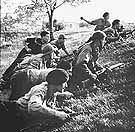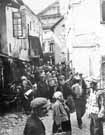
|
|
|

|

|

|

|
|
Click on an image to see a larger, more detailed picture.
|
|
|
|
|
| 1941: Mass Murder |

|
pg. 252 |

|
|
|
|
| |
 The most important Resistance group in Occupied France was the FFI (Free French Insurgency), whose troops are pictured. Commanded by General Charles de Gaulle, the Free French opposed recognition of the Vichy regime, a puppet government established by the Nazis. The FFI coordinated much of the resistance activity within Occupied France and established an army that would participate in the approaching reconquest of Europe.
The most important Resistance group in Occupied France was the FFI (Free French Insurgency), whose troops are pictured. Commanded by General Charles de Gaulle, the Free French opposed recognition of the Vichy regime, a puppet government established by the Nazis. The FFI coordinated much of the resistance activity within Occupied France and established an army that would participate in the approaching reconquest of Europe.
Photo: Archive Photos
|
 A Latvian civilian is executed by a member of the notorious Einsatzgruppen. This sort of execution--absurdly time-consuming as well as barbarous--was never abandoned by the efficiency-minded Nazis.
A Latvian civilian is executed by a member of the notorious Einsatzgruppen. This sort of execution--absurdly time-consuming as well as barbarous--was never abandoned by the efficiency-minded Nazis.
Photo: State Archive of the Russian Federation / United States Holocaust Memorial Museum Photo Archive
|
 Vilna Ghetto
Vilna Ghetto
Known as the "Jerusalem of Lithuania," Vilna was a regional center of Jewish culture. Prior to German occupation, Jews numbered 60,000, over one-fourth of the city's population. In the summer of 1941, however, Einsatzkommandos and Lithuanian collaborators rousted Vilna Jews from their homes and marched them toward the prison yard. Held outdoors for several days, men and women were separated, put on board trucks, and told they would work. Instead the Jews were dumped in the hilly Ponary Forest. Divided into small groups, they were led to an execution site. "Suddenly the truth hit us, like an electric shock," remembered a survivor. Women with "piteous pleas" kissed the boots of their executioners, futilely offering rings and watches. Up to 20,000 were slaughtered. In September the Germans set up two ghettos for the remaining Jews. Ghetto No. 1 housed workers, while the smaller No. 2 imprisoned the "unproductive." In October the Nazis exterminated all 11,000 inmates of Ghetto No 2; in November, thousands more from Ghetto No. 1 were killed. By December 40,000 were dead. The 20,000 still alive became a workforce for the Germans until the ghetto was liquidated in 1943. Those fit for work went to labor camps; those "unfit" were banished to extermination camps. Only 2000 to 3000 survived.
Photo: American Jewish Joint Distribution Committee / United States Holocaust Memorial Museum Photo Archive
|
|

|

|

|

|
 August 1941: German troops in Slobodka, Ukraine, fill the local synagogue with dead cats and force Jews to tear up the Torah scrolls and scatter the pieces atop the dead animals. The Nazi troops then set fire to the building.
August 1941: German troops in Slobodka, Ukraine, fill the local synagogue with dead cats and force Jews to tear up the Torah scrolls and scatter the pieces atop the dead animals. The Nazi troops then set fire to the building.
|
 August 1941: Father Bernhard Lichtenberg, dean of St. Hedwig's Cathedral in Berlin, denounces the so-called euthanasia program. In late October he declares that he wants to share the Jews' fate of deportation to the East so that he can continue to pray for them there. He is subsequently denounced to the Gestapo and arrested.
August 1941: Father Bernhard Lichtenberg, dean of St. Hedwig's Cathedral in Berlin, denounces the so-called euthanasia program. In late October he declares that he wants to share the Jews' fate of deportation to the East so that he can continue to pray for them there. He is subsequently denounced to the Gestapo and arrested.
|
|
|
|
|
| 1941: Mass Murder |

|
pg. 252 |

|
|
The Holocaust Chronicle
© 2009 Publications International, Ltd.
|
|
